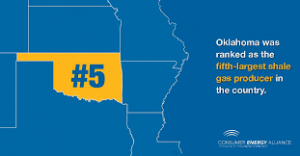
A report by the Consumer Energy Alliance says expanded pipeline infrastructure and more dependency on natural gas helped Oklahoma families and businesses save nearly $19 billion between 2008 and 2018. But it also warns those savings are threatened by out-of-state activists.
The greatest saving of $16.7 billion came for commercial and industrial users, reported the CEA while households had savings of more than $1.8 billion.
Called “Oil and Natural Gas Energize Oklahoma,” the report served as a reminder of how essential affordable, reliable energy is to the nation’s supply chains and manufacturing infrastructure, according to the CEA. It also highlights the savings for consumers because of enhanced energy supplies.

But the CEA pointed out the future of Oklahoma’s energy resources and its pipeline network is currently threatened by heavily-funded, out-of-state activists who continue working to eliminate the production and transportation of safe, affordable sources of energy without offering any viable solutions that would help our country meet consumer demand and environmental goals.
“This report demonstrates how Oklahoma’s families, farmers, industries and small businesses benefit from an all-of-the-above energy strategy that continues to emphasize the importance of natural gas in benefiting Oklahoma – especially during these uncertain economic times for our communities,” said CEA Oklahoma Director Ryan Scott.
“Whether through business, commerce, harvesting, or home use, we all depend on energy. It’s also an essential component to an economic recovery. That’s why we need to support U.S. energy in all forms while we continue to advance our world-leading environmental progress – it’s key to us being prepared and having the energy we need.”

Highlights from the report include:
- Oklahoma’s families and small businesses have benefited to the tune of more than $18.6 billion in energy savings from 2008 to 2018. Residential users alone saved over $1.8 billion and commercial and industrial users saved more than $16.7 billion combined.
- On average, each Oklahoma resident spent $4,331 for their energy needs in 2018. For those living at or below the poverty line, this translates to almost a third of their income going toward energy expenses.
- Almost 40% of the natural gas delivered to consumers within the state is used for electricity generation, and about half of the homes in Oklahoma rely on natural gas for heat.
- Unfortunately, 15.6% of Oklahoma’s people were living in poverty in 2019, one of the highest rates in the country. That is roughly 597,000 men, women and children – enough people to fill up the Sooners Owen Field almost 8 times.
- Oklahoma is the nation’s fourth-largest petroleum-producing state. Since energy is a driver of the state’s economy, in 2018, the Oklahoma oil and gas industry’s total economic impact was 135,300 jobs with total household earnings of $19.2 billion, and $37 billion in gross domestic product.
- For fiscal year 2019, Oklahoma’s gross production taxes totaled nearly $1.13 billion, which is revenue that plays a critical role in stabilizing the state’s budget through the Rainy Day Fund.
- Taxes from oil and gas production also help local communities. In FY2019, $103.8 million was sent to counties for roadways and another $103.8 million allocated for local school districts. Additionally, $245 million was dedicated to education-related funds, including higher education and student aid.
- In 2019, the U.S. recorded the largest CO2 emissions reductions of any country – a decline of 2.9 percent, occurring at a time when our country became the world’s leading producer of oil and natural gas.
To view the report, click here.
Source: Consumer Energy Alliance





